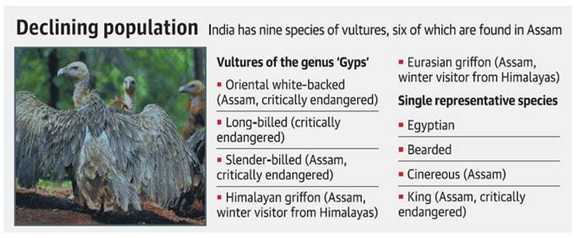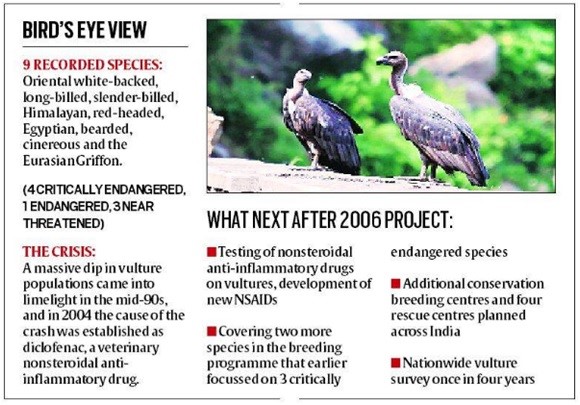Mudumalai Tiger Reserve
Context:
- Vulture population on the rise in the buffer zone of the Mudumalai Tiger Reserve (MTR).
More about news:
- A recent study of the population of vultures in the Sigur plateau has found that the population of all four resident vulture species have seemingly been on the rise over the past few years.
- Majority of them are the critically-endangered white-rumped vulture (Gyps bengalensis),
- followed by the long-billed vulture (Gyps indicus),
- the red-headed vulture (Sarcogyps calvus) and
- the egyptian vulture (Neophron percnopterus).
- The study is indicative that there are good nesting sites for vultures, as well as excellent food availability, which in turn points to a healthy number of carnivores, whose kills the vultures depend on for food.
- Another encouraging sign was the increasing number of juvenile asian king vultures.
Why vultures are important to protect nature?
- Human race has encountered many viruses like COVID-19, our rich biodiversity plays a huge role in keeping the germs at check.
- Of the many organisms, vultures, as carcass feeders, play a significant role. The scavenger birds hold the key for a natural mechanism of infection control.
- Vultures are the scavengers who do the work of cleaning up, and keeping the ecosystem healthy.The beauty is, despite feeding on infected carcass, vultures do not get infected.
- The acids in their stomach are potent enough to kill the pathogen. Thus, the chain of infection is broken. It invisibly controls the spread of harmful pathogens causing deadly anthrax, cholera, foot and mouth disease, rabies and distemper.
- The birds also prevent the contamination of water sources, especially in the wild.
- When animals die near watering hole, there is an imminent danger of contamination resulting in a quick spread of infections and mass death.
- But vultures devour the carcasses in totality thereby preventing a tragic mishap.
In India, we have nine species of vultures
- One can spot the long-billed vulture (Indian vulture), red-headed vulture, white-rumped vulture and the Egyptian vulture in the Nilgiris Biosphere of the Western Ghats.
- In the last four years, the population has grown by may be 10 percent. Restoring the population is an uphill task as vultures are slow breeders.
- If they become extinct, there will be a huge ripple effect. Other scavengers like rats and dogs may take over, temporarily, but with that comes problems like increased incidence of rabies.
- According to scientific studies, a veterinary, non-steroidal, anti-inflammatory drug called diclofenac administered to cattle had led to a catastrophic decline of vulture species in the South Asian region.
- Though diclofenac is now banned, other equally harmful drugs are still in use,” he adds. Bharathidasan, however, is hopeful that vultures will be back in large numbers and circling the blue skies.


Mudumalai National Park
- The Mudumalai National Park and Wildlife Sanctuary also a declared tiger reserve, lies on the northwestern side of the Nilgiri Hills (Blue Mountains), in Tamil Nadu, India.
- It shares its boundaries with the states of Karnataka and Kerala.
- The protected area is home to several endangered and vulnerable species including Indian elephant, Bengal tiger, gaur and Indian leopard.
- There are at least 266 species of birds in the sanctuary, including critically endangered Indian white-rumped vulture and long-billed vulture.
https://www.thehindu.com/news/national/tamil-nadu/vulture-population-on-the-rise-in-tiger-reserve/article35530665.ece?homepage=true



1.png)
